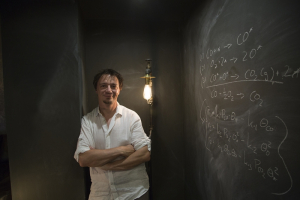Perhaps one of the most desirable qualities of gold – especially to those wearing it as jewelry – is its ability to hold onto its bright, shining glow. Gold can resist rusting and tarnishing when exposed to air or water because it’s inert, meaning it’s one of the least reactive of all metals.
But gold has some unexpected properties, too. For instance, gold nanoparticles can be used as a catalyst to oxidize carbon monoxide (CO) into carbon dioxide (CO2) – a puzzling quality for a metal which isn’t supposed to be reactive. For the past 25 years, researchers have observed the catalytic behaviors of gold and proposed many explanations as to why an inert metal would help to speed up a chemical reaction. Until now, no single model has completely explained what takes place during a reaction wherein gold is used to help transform CO into CO2.
A professor and Ph.D. student at the UH Cullen College of Engineering have created the first-ever model to fully explain what happens during the catalytic oxidation of carbon monoxide. Lars Grabow, assistant professor of chemical and biomolecular engineering with the Cullen College, conducted this research alongside his Ph.D. student, Hieu Doan. The collaborators on this project were Bert Chandler, Johnny Saavedra, and Christopher Pursell at Trinity University in San Antonio. Together, they have published their findings in the latest issue of Science.
The catalytic oxidation that transforms CO into CO2 has always relied on one basic, elementary notion: carbon monoxide reacts with oxygen to form CO2. However, Saavedra, Pursell, and Chandler observed through their research that something else might be playing a hidden role in this reaction, working with the gold particles to speed up the process of CO oxidation.
“So at that point, Hieu stepped in and said he wanted to explain why this happened and started doing some basic calculations,” Grabow explained. “It all started with that – just some basic calculations – then it led to this paper.”
Using the best available experimental and theoretical methods in combination, the team was able to provide direct evidence of the role each element plays in this particular chemical reaction, and pinpointed exactly how gold is able to act like a catalyst within the reaction.
“The answer is water,” Grabow said. Although water is not one of the reactants in this chemical reaction, Grabow’s team was able to prove that it serves as a co-catalyst for the reaction.
But if water isn’t intentionally added to the chemical reaction, how does it get there in the first place? “Well, water is everywhere,” Grabow explained. “It’s in the air and we know it as humidity. More importantly, it’s in pretty much every chemical reactor that we’re operating unless it’s inside of an ultra-high vacuum, of course.”
The presence of tiny amounts of water is what essentially drives the reaction on the surface of the gold catalysts. A thin layer of water, approximately 2 molecular layers, settles on the surface of the catalyst, and protons (positively charged hydrogen atoms) from inside the water layer can detach from the water molecules and attach themselves to oxygen molecules. Those protonated oxygen molecules are then absorbed onto the surface of the gold catalyst, allowing the reaction to proceed very quickly. When the reaction is complete, the protons return once again to the water layer on the surface of the catalyst.
“We imagine that the layer of water is like a sea of protons and they just swim in that water layer like fish and they jump out to facilitate the reaction then they jump back into the water layer,” Grabow said.
Although people have been experimenting with CO oxidation using gold catalysts for nearly 30 years and many researchers have reported that water can change the reaction kinetics quite drastically, Grabow noted that until now no research has ever reported the exact mechanism that his group identified in their Science article.
“There are many models to describe this, but all of the previous models contain only a subset of the system components and typically focus on the effect of an individual component. We are the first ones to put all of this together in a single model that fully supports Chandler’s experimental observations, and we can say with a high degree of certainty that we now understand the role of each of the components and what they do during this catalytic reaction,” said Grabow.
However, Grabow was quick to point out that his student, Doan, conducted the bulk of the work which led to their novel model of what’s happening on the surface of the gold catalyst, “which, in our opinion, is the best model that’s been developed for this system,” said Grabow.
Doan said he started this work simply by visualizing the surface of the gold catalyst. “I pictured what the catalyst surface would look like, then I thought about all the individual components of the catalyst – gold nanoparticles, titanium oxide support, and water. From there, I came up with a model to describe what’s happening in this reaction so we can visualize all of the elements of the catalyst and bring them together in a scientific way,” he explained.
Doan will be completing his Ph.D. at the Cullen College in one short year. Although he hasn’t settled yet on exactly what he wants to do after completing his degree, he said he hopes to continue his research within Grabow’s lab in some capacity or another.
